Ordinary workers behind China's Spring Festival travel rush
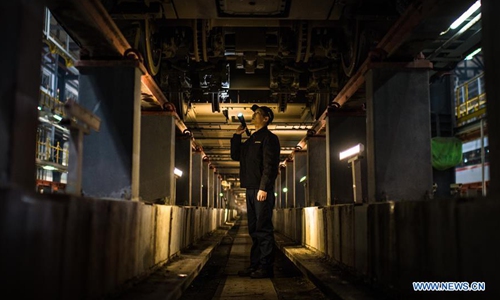
Wang Huihui, a mechanician for ground service, works at the bullet train overhaul base in central China's Hubei Province, Jan. 3, 2020. China, the world's most populated country, on Jan. 10 ushered in its largest annual migration, 15 days ahead of the Spring Festival, or the Lunar New Year. This year, three billion trips will be made during the travel rush from Jan. 10 to Feb. 18 for family reunions and travel, according to official forecast. The 40-day travel rush is known as Chunyun in Chinese. The Lunar New Year falls on Jan. 25 this year, earlier than previous years, which brings a bigger challenge to the transport system as the return trips of college students overlap with the travel rush. Among all means of transportation, high-speed railway is the most favored for the Chunyun travelers. China's high-speed railway network tops the world with an estimated length of 35,000 km by the end of 2019. Traveling by high-speed rail is not merely fast but also comfortable. Facilitated by new technologies, such as online booking and "face-scanning" check-in service, and advanced transport facilities, people have enjoyed shortened journey time as well as pleasant convenience. But to make all these happen, a large number of railway staff have to work with their utmost efforts during this busiest period of time for the whole year. Most of them are just ordinary workers unknown by the travelers they serve. (Xinhua/Xiao Yijiu)

Wang Erling, a washing worker for train bedding, arranges the freshly ironed bedding at the washing center of Wuhan Passenger Transport Department in central China's Hubei Province, Jan. 6, 2020. China, the world's most populated country, on Jan. 10 ushered in its largest annual migration, 15 days ahead of the Spring Festival, or the Lunar New Year. This year, three billion trips will be made during the travel rush from Jan. 10 to Feb. 18 for family reunions and travel, according to official forecast. The 40-day travel rush is known as Chunyun in Chinese. The Lunar New Year falls on Jan. 25 this year, earlier than previous years, which brings a bigger challenge to the transport system as the return trips of college students overlap with the travel rush. Among all means of transportation, high-speed railway is the most favored for the Chunyun travelers. China's high-speed railway network tops the world with an estimated length of 35,000 km by the end of 2019. Traveling by high-speed rail is not merely fast but also comfortable. Facilitated by new technologies, such as online booking and "face-scanning" check-in service, and advanced transport facilities, people have enjoyed shortened journey time as well as pleasant convenience. But to make all these happen, a large number of railway staff have to work with their utmost efforts during this busiest period of time for the whole year. Most of them are just ordinary workers unknown by the travelers they serve. (Xinhua/Cheng Min)
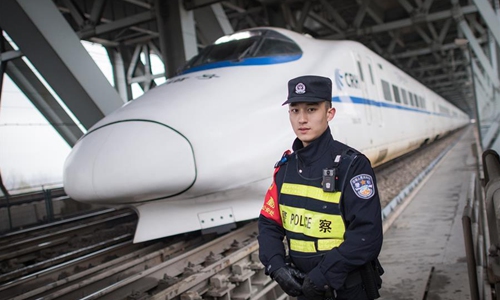
Zhou Chenyu, a railway policeman of Wuhan, patrols on the Tianxingzhou bridge over the Yangtze River in Wuhan, central China's Hubei Province, Jan. 6, 2020. China, the world's most populated country, on Jan. 10 ushered in its largest annual migration, 15 days ahead of the Spring Festival, or the Lunar New Year. This year, three billion trips will be made during the travel rush from Jan. 10 to Feb. 18 for family reunions and travel, according to official forecast. The 40-day travel rush is known as Chunyun in Chinese. The Lunar New Year falls on Jan. 25 this year, earlier than previous years, which brings a bigger challenge to the transport system as the return trips of college students overlap with the travel rush. Among all means of transportation, high-speed railway is the most favored for the Chunyun travelers. China's high-speed railway network tops the world with an estimated length of 35,000 km by the end of 2019. Traveling by high-speed rail is not merely fast but also comfortable. Facilitated by new technologies, such as online booking and "face-scanning" check-in service, and advanced transport facilities, people have enjoyed shortened journey time as well as pleasant convenience. But to make all these happen, a large number of railway staff have to work with their utmost efforts during this busiest period of time for the whole year. Most of them are just ordinary workers unknown by the travelers they serve. (Xinhua/Xiao Yijiu)
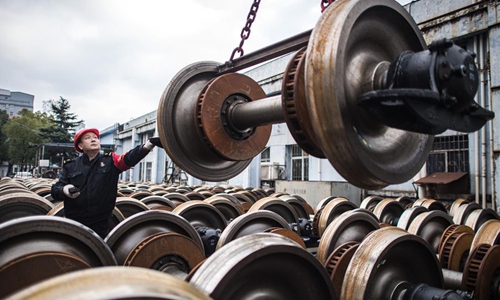
Liu Wei, a train wheel quality inspector, works at the Wuchang Depot of China Railway Wuhan Group Co., Ltd. in central China's Hubei Province, Jan. 7, 2020. China, the world's most populated country, on Jan. 10 ushered in its largest annual migration, 15 days ahead of the Spring Festival, or the Lunar New Year. This year, three billion trips will be made during the travel rush from Jan. 10 to Feb. 18 for family reunions and travel, according to official forecast. The 40-day travel rush is known as Chunyun in Chinese. The Lunar New Year falls on Jan. 25 this year, earlier than previous years, which brings a bigger challenge to the transport system as the return trips of college students overlap with the travel rush. Among all means of transportation, high-speed railway is the most favored for the Chunyun travelers. China's high-speed railway network tops the world with an estimated length of 35,000 km by the end of 2019. Traveling by high-speed rail is not merely fast but also comfortable. Facilitated by new technologies, such as online booking and "face-scanning" check-in service, and advanced transport facilities, people have enjoyed shortened journey time as well as pleasant convenience. But to make all these happen, a large number of railway staff have to work with their utmost efforts during this busiest period of time for the whole year. Most of them are just ordinary workers unknown by the travelers they serve. (Xinhua/Xiao Yijiu)

Sun Fanjun (R), a ticket inspector, helps a passenger at Hankou Railway Station in Wuhan, central China's Hubei Province, Jan. 5, 2020. China, the world's most populated country, on Jan. 10 ushered in its largest annual migration, 15 days ahead of the Spring Festival, or the Lunar New Year. This year, three billion trips will be made during the travel rush from Jan. 10 to Feb. 18 for family reunions and travel, according to official forecast. The 40-day travel rush is known as Chunyun in Chinese. The Lunar New Year falls on Jan. 25 this year, earlier than previous years, which brings a bigger challenge to the transport system as the return trips of college students overlap with the travel rush. Among all means of transportation, high-speed railway is the most favored for the Chunyun travelers. China's high-speed railway network tops the world with an estimated length of 35,000 km by the end of 2019. Traveling by high-speed rail is not merely fast but also comfortable. Facilitated by new technologies, such as online booking and "face-scanning" check-in service, and advanced transport facilities, people have enjoyed shortened journey time as well as pleasant convenience. But to make all these happen, a large number of railway staff have to work with their utmost efforts during this busiest period of time for the whole year. Most of them are just ordinary workers unknown by the travelers they serve. (Xinhua/Xiao Yijiu)
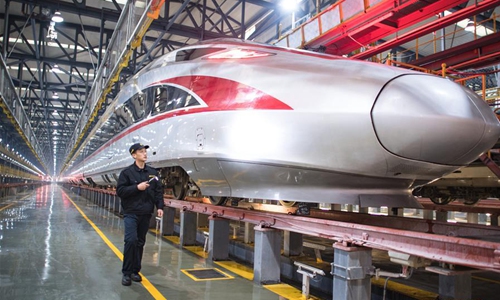
Wang Huihui, a mechanician for ground service, inspects a Fuxing bullet train at the bullet train overhaul base in central China's Hubei Province, Jan. 3, 2020. China, the world's most populated country, on Jan. 10 ushered in its largest annual migration, 15 days ahead of the Spring Festival, or the Lunar New Year. This year, three billion trips will be made during the travel rush from Jan. 10 to Feb. 18 for family reunions and travel, according to official forecast. The 40-day travel rush is known as Chunyun in Chinese. The Lunar New Year falls on Jan. 25 this year, earlier than previous years, which brings a bigger challenge to the transport system as the return trips of college students overlap with the travel rush. Among all means of transportation, high-speed railway is the most favored for the Chunyun travelers. China's high-speed railway network tops the world with an estimated length of 35,000 km by the end of 2019. Traveling by high-speed rail is not merely fast but also comfortable. Facilitated by new technologies, such as online booking and "face-scanning" check-in service, and advanced transport facilities, people have enjoyed shortened journey time as well as pleasant convenience. But to make all these happen, a large number of railway staff have to work with their utmost efforts during this busiest period of time for the whole year. Most of them are just ordinary workers unknown by the travelers they serve. (Xinhua/Xiao Yijiu)
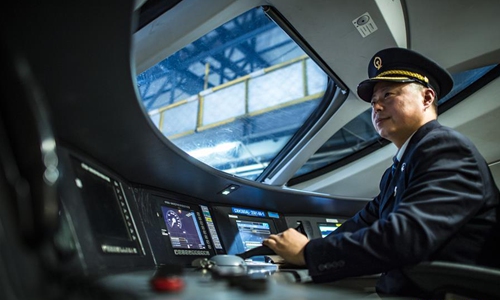
Guo Xiaozhen, a driver with the Wuchangnan locomotive depot of China Railway Wuhan Group Co., Ltd., is seen in the driving cab of a bullet train in central China's Hubei Province, Jan. 3, 2020. China, the world's most populated country, on Jan. 10 ushered in its largest annual migration, 15 days ahead of the Spring Festival, or the Lunar New Year. This year, three billion trips will be made during the travel rush from Jan. 10 to Feb. 18 for family reunions and travel, according to official forecast. The 40-day travel rush is known as Chunyun in Chinese. The Lunar New Year falls on Jan. 25 this year, earlier than previous years, which brings a bigger challenge to the transport system as the return trips of college students overlap with the travel rush. Among all means of transportation, high-speed railway is the most favored for the Chunyun travelers. China's high-speed railway network tops the world with an estimated length of 35,000 km by the end of 2019. Traveling by high-speed rail is not merely fast but also comfortable. Facilitated by new technologies, such as online booking and "face-scanning" check-in service, and advanced transport facilities, people have enjoyed shortened journey time as well as pleasant convenience. But to make all these happen, a large number of railway staff have to work with their utmost efforts during this busiest period of time for the whole year. Most of them are just ordinary workers unknown by the travelers they serve. (Xinhua/Xiao Yijiu)
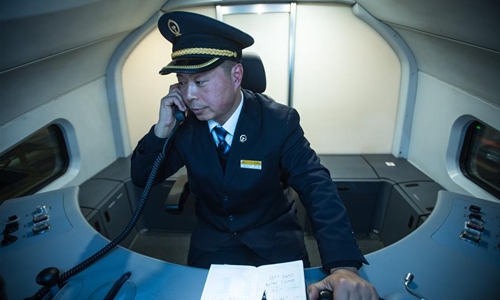
Guo Xiaozhen, a driver with the Wuchangnan locomotive depot of China Railway Wuhan Group Co., Ltd., is seen in the driving cab of a bullet train in central China's Hubei Province, Jan. 3, 2020. China, the world's most populated country, on Jan. 10 ushered in its largest annual migration, 15 days ahead of the Spring Festival, or the Lunar New Year. This year, three billion trips will be made during the travel rush from Jan. 10 to Feb. 18 for family reunions and travel, according to official forecast. The 40-day travel rush is known as Chunyun in Chinese. The Lunar New Year falls on Jan. 25 this year, earlier than previous years, which brings a bigger challenge to the transport system as the return trips of college students overlap with the travel rush. Among all means of transportation, high-speed railway is the most favored for the Chunyun travelers. China's high-speed railway network tops the world with an estimated length of 35,000 km by the end of 2019. Traveling by high-speed rail is not merely fast but also comfortable. Facilitated by new technologies, such as online booking and "face-scanning" check-in service, and advanced transport facilities, people have enjoyed shortened journey time as well as pleasant convenience. But to make all these happen, a large number of railway staff have to work with their utmost efforts during this busiest period of time for the whole year. Most of them are just ordinary workers unknown by the travelers they serve. (Xinhua/Xiao Yijiu)
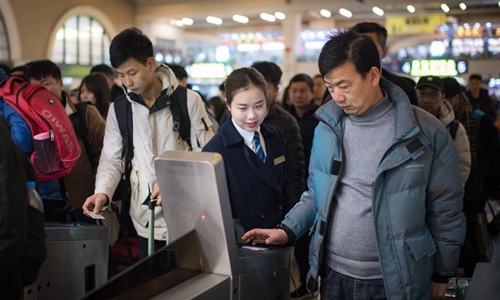
Sun Fanjun (C), a ticket inspector, guides passengers through ticket gates at Hankou Railway Station in Wuhan, central China's Hubei Province, Jan. 5, 2020. China, the world's most populated country, on Jan. 10 ushered in its largest annual migration, 15 days ahead of the Spring Festival, or the Lunar New Year. This year, three billion trips will be made during the travel rush from Jan. 10 to Feb. 18 for family reunions and travel, according to official forecast. The 40-day travel rush is known as Chunyun in Chinese. The Lunar New Year falls on Jan. 25 this year, earlier than previous years, which brings a bigger challenge to the transport system as the return trips of college students overlap with the travel rush. Among all means of transportation, high-speed railway is the most favored for the Chunyun travelers. China's high-speed railway network tops the world with an estimated length of 35,000 km by the end of 2019. Traveling by high-speed rail is not merely fast but also comfortable. Facilitated by new technologies, such as online booking and "face-scanning" check-in service, and advanced transport facilities, people have enjoyed shortened journey time as well as pleasant convenience. But to make all these happen, a large number of railway staff have to work with their utmost efforts during this busiest period of time for the whole year. Most of them are just ordinary workers unknown by the travelers they serve. (Xinhua/Xiao Yijiu)
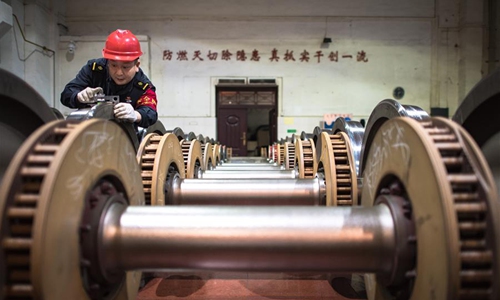
Liu Wei, a train wheel quality inspector, works at the Wuchang Depot of China Railway Wuhan Group Co., Ltd. in central China's Hubei Province, Jan. 7, 2020. China, the world's most populated country, on Jan. 10 ushered in its largest annual migration, 15 days ahead of the Spring Festival, or the Lunar New Year. This year, three billion trips will be made during the travel rush from Jan. 10 to Feb. 18 for family reunions and travel, according to official forecast. The 40-day travel rush is known as Chunyun in Chinese. The Lunar New Year falls on Jan. 25 this year, earlier than previous years, which brings a bigger challenge to the transport system as the return trips of college students overlap with the travel rush. Among all means of transportation, high-speed railway is the most favored for the Chunyun travelers. China's high-speed railway network tops the world with an estimated length of 35,000 km by the end of 2019. Traveling by high-speed rail is not merely fast but also comfortable. Facilitated by new technologies, such as online booking and "face-scanning" check-in service, and advanced transport facilities, people have enjoyed shortened journey time as well as pleasant convenience. But to make all these happen, a large number of railway staff have to work with their utmost efforts during this busiest period of time for the whole year. Most of them are just ordinary workers unknown by the travelers they serve. (Xinhua/Xiao Yijiu)